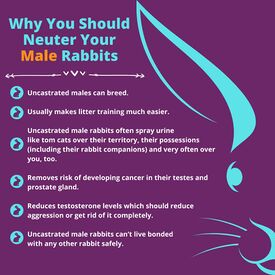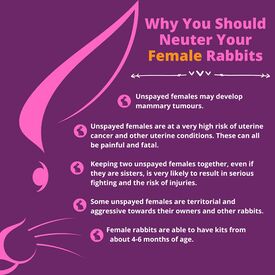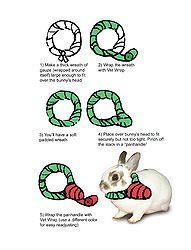Spaying and neutering rabbits
A spay or ovariohysterectomy is the removal of the uterus and ovaries from a female rabbit. A neuter, castration, or orchidectomy is the removal of the testes from the scrotal sacs in a male rabbit. Although usually reserved in reference to males, neutering can also refer to a spay as the term technically refers to the removal of reproductive organs, regardless of sex.[1] Colloquially, the terms altering or fixing is used to refer to the gender-neutral procedure.
Reasons to spay and neuter
Surgery for spaying and neutering can be as safe on rabbits as any animal, given that you find an experienced veterinarian to perform the procedure. Mortality rates for a skilled veterinarian should be no more than 1%, and most of the danger is from the anesthesia.
The House Rabbit Society has had over 1000 rabbits spayed or neutered with approximately 0.1% mortality due to anesthesia.[2] Dolly's Dream Home Rabbit Rescue reports that they have spayed and neutered over 1,400 rabbits and lost less than 1%. Necropsies have mostly shown that the bunnies had underlying birth defects, usually heart-related, that made the anesthesia too much for them.[3]
Overall benefits

- Healthier and live longer than unaltered rabbits.[2]
- Calmer, more loving, and dependable once urge to mate is removed.[2]
- Less prone to destructiveness (chewing, digging) and aggressiveness (biting, lunging, circling, growling) behavior after surgery.[2]
- Easier and more reliable to litter train.[2]
- Will not contribute to the overpopulation of pet rabbits.[2] Having a spayed or neutered rabbit in the case that rehoming is necessary will make the pet easier to adopt out and give reassurance that the rabbit will not go on to make any unwanted babies.
- Can safely have a friend to bond with.[2] Hormones will encourage sexual and aggressive behaviors toward other rabbits.
The Rabbit Welfare Association and Fund posted on their FB page:
Pet owners usually get their cats and dogs neutered (spayed or castrated), but don’t always think twice about getting their rabbits fixed – until an unexpected litter arrives 👀 Rabbits can have kits from as young as 4-6 months old! So if you don’t want an accidental litter please make sure to get your rabbits neutered!
Rescue centres already have extensive waiting lists and simply cannot cope with more unwanted rabbit litters, so it’s up to you to ‘fix’ this problem and take responsibility by neutering your rabbits. As well as preventing unwanted litters, neutering your rabbits can help with training, bonding, reducing aggression, and preventing several forms of cancer. For more information, please visit our website: https://rabbitwelfare.co.uk/rabbit-health/medical/neutering/
Female spaying
- Eliminates all or reduces risk of developing fatal reproductive cancers (ovarian, uterine, mammarian) and diseases (e.g. pyometra).[2] There is a high 50%-80% incidence rate of uterine cancer in intact does over the age of 4 years based on certain research studies. See Uterine Cancer for more information.
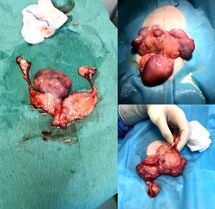
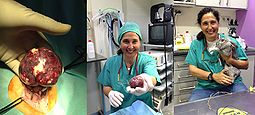
- Prevents pseudopregnancy. It is stressful for rabbits to go through nest building, milk production and aggressive protection of territory. This can make the pet very difficult to handle during this period and can progress to decreased appetite and gastrointestinal problems.[4]
Male neutering
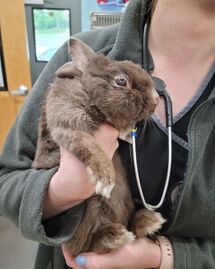
- Reduces sexual aggression.[2]
- Stops spraying behavior.[2]
- Reduces and eliminates risks of testicular and prostate cancers (although risks are not conclusively proven through research).[5]
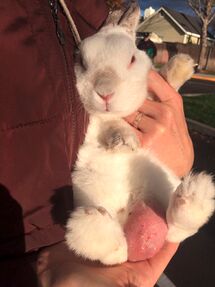
Dr. Nic (the Animal Doctor) @ at OSU Veterinary Medical Hospital posts on why he recommends neutering male rabbits.
- Prevent inguino-scrotal hernia, a not uncommon condition in the elder rabbit, which can be difficult to treat.
- Prevent testicular disorders, especially neoplasia.
- Reduces the chance that a male rabbits is overly aggressive or sprays in the house.
Myths
Several myths have been perpetuated about spaying and neutering pets.
- Your pet will not become "fat and lazy" after being altered. A lack of exercise, too much food, and boredom will cause an animal to be so, regardless of neutering.[6]
- Your pet will still be bonded with you after their surgery. While your rabbit may be calmer due to lack of hormonal frustrations, the underlying personality will not be changed, especially if altered at a young age. However, if you are basing your rabbit's personality on hormone-driven behaviors such as circling, humping, and biting, then such behaviors will be eliminated or reduced after altering.
Age to spay and neuter
Depending on its genetic makeup, a rabbit will reach sexual maturity somewhere between the age of 3 to 8 months.[6] See the Health FAQ question "When do rabbits mature?" for more details.
Although not all rabbits will show undesirable habits upon reaching sexual maturity, most rabbits do. Behaviors include the following:[6]
- loss of previously good litterbox habits
- spraying urine
- mounting and humping of objects such as toys or your body
- growling and boxing
- territorial biting and nipping
- aggressive and possessive lunging and biting
- circling and honking
- excessively destructive chewing and digging (especially in females)
As Dana Krempels writes,[6]
When intact, both male and female rabbits usually mount one another endlessly out of sex drive and/or to establish social dominance. Same-sex pairs who tolerated each other as babies will often begin ferocious fighting upon reaching sexual maturity. This can result in permanent "unbonding," not to mention serious physical injury.
Opposite sex pairs will begin reproducing as soon as they mature. Left unchecked, an unspayed rabbit and her intact female descendants can produce more than 1300 offspring in a year. Over the course of five years this number balloons exponentially to more than 94 million!
Females can usually be spayed as soon as they become sexually mature, around 5 months old.[7]:87 It is advisable to spay females after puberty but before maturity when large amounts of abdominal fat can complicate the surgery.[7]:87 An immature rabbit will have structures that are not well developed, making the surgery more difficult.[7]:87 Some veterinarians may want to wait until the rabbit is older at ~6 months.[2]
Males can be neutered as soon as their testicles descend, usually around 4 months of age.[7]:87 Some rabbits may have testicles descend at around 10-12 weeks.[8] Motile spermatozoa appear in the ejaculate from about 4 months of age.[7]:87 Some veterinarians may want to wait until the rabbit is older at ~5 months.[2][9] If they are too young, the neutering may require abdominal surgery which makes the process more complicated.[4] Males can be considered sterile 5-6 weeks after the operation.[7]:87
Older rabbits (6+ yrs) may need to have blood work done beforehand to make sure they do not react negatively to anesthesia. Age is not a disease, and as long as the rabbit is in good health, they can be a good candidate for surgery. Small rabbits may need to grow bigger before they may be dosed with an anesthetic for surgery. Giant breeds of rabbits may reach maturity at an older age so the surgery may be done later if necessary.[10]
Choosing a clinic
To choose a veterinarian for the procedure, some good questions to ask are the following:[2]
- About how many rabbit clients does the veterinarian see in a year?
- How many spays and neuters of rabbits has the veterinarian has done in the past year?
- What is your success rate? If any were lost, what was the cause? According to the House Rabbit Society,[2]
Dolly's Dream Home Rabbit Rescue writes,90% success is way too low. Every doctor, whether for animals or humans will occasionally lose a patient; usually because of an undiagnosed problem. Veterinarians across the country who spay and neuter rabbits for the House Rabbit Society have lost on average less than 1/2 of 1%.
At our rescue, we’ve spayed or neutered over 1,400 bunnies and lost less than 1% due to surgical complications. In these rare instances, necropsies have mostly shown that the bunnies had underlying birth defects, usually heart-related, that made the anesthesia too much for them.
With a rabbit-savvy, exotic veterinarian, fixing your bunny is not just safe, but necessary.
- Does the veterinarian remove both uterus and ovaries? They should be. Uterine cancer prevention requires the entire removal of the organ, and without the removal of the ovaries, the rabbit will still be hormonal and problematic behaviors will not cease after the operation.
- Is entry to the testicles made through the scrotum or the abdomen? Entry via the abdomen unnecessarily increases the trauma for male rabbits.
- Does the veterinarian require withholding of food and water prior to surgery in rabbits? Rabbits should never be fasted before surgery. Rabbits cannot vomit, so there is no risk of that during surgery, and rabbits should never be allowed to get empty digestive tracts.
- What anesthetics are used? Make sure it's rabbit-safe. Some common anesthetics used include isoflurane and sevoflurane. See Drugs for more resources.
- Review the procedure (op and immediate post-op) with your vet. See the Costs section below for more procedure-related questions.
Check out Low Cost Spay/Neuter Clinics for some low-cost options to spay and neuter your rabbit.
The links below are some more resources when choosing a veterinarian for surgical procedures.
- Jan Langer. (2003). Surgery Considerations
Costs of a spay or neuter
Costs of a spay or neuter will vary based on your location and availability of the service. On the low end, the procedure can begin at ~US$50 at low cost spay/neuter clinics. At private veterinarians, the cost can be US$200+ due to additional tests and monitoring to reduce surgery risks. To properly compare costs, please take a look at your line-by-line invoice that breaks down all the costs.
You can find a database of anonymous rabbit spay/neuter bills here.
Usually, a neuter is less expensive than a spay; however, if a male rabbit has cryptorchidism or undescended testicles, the costs may end up similar to a spay due to the more invasive procedure.
You can find more about the cheaper options at Low cost spay/neuter clinics.
From the Colorado House Rabbit Society, [11] with additional comments:
There is a wide variety of charges for a rabbit spay or neuter. Before deciding who to use, find out what the differences are in the care your rabbit will get. Specifically:
- Is a thorough "exotic exam" done? If not, is any kind of exam done? A pre-exam usually costs US$40-100 depending on location.
- Is pre-anesthetic blood-work done? If so, this cost is usually US$100-300. This is usually a good idea to reduce risk by detect any congenital or kidney/liver issues that may make surgery with anesthesia riskier.
- Is the anesthetic used injected or is it a gas (which is much safer)? Common choices for gas anesthetics are isoflurane and sevoflurane. Low-cost clinics may choose to use injectable anesthetics.
- Is the rabbit intubated (a breathing tube placed)? Low-cost clinics often will not intubate rabbits.
- Is a vet tech monitoring the rabbit's vital signs throughout the surgery? Low-cost clinics often do not have the extensive extra monitoring that private clinics may use.
- What monitoring equipment is used?
- Respiratory monitor?
- Blood pressures?
- Body temperature?
- Is an IV catheter and fluids used throughout the surgery? Low-cost clinics often will not use any IV catheters that private clinics may use.
- Are pain medications given either before or after the surgery? A shot of buprenorphine for pain and possibly a motility drug to jump start their digestive system are common before or after the surgery. Common sedatives used before the surgery include ketamine and midazolam.
- How is the skin closed?
- Will there be external sutures or staples which need to be removed?
- Is the rabbit kept overnight?
- If so, why? (i.e., will there be someone monitoring the rabbit throughout the night?)
- Is any pain medication sent home with the rabbit for use later that day or the next day? Additional pain medications are usually US$20-50.
The following article describes the differences in care that may occur between a private veterinary clinic and a low-cost spay/neuter clinic that will greatly affect the surgery costs and risks of the procedure:
- Carolyn Karrh. (2015). THE DIFFERENCE
Care
Surgery can be very emotionally and mentally stressful, and the following tips can help you and your rabbit get through this operation with maximal safety and minimal worries.
Before the operation
- Make sure to schedule surgery with a rabbit-savvy veterinarian. The veterinarian should be very familiar with the rabbit's unique anatomy and physiology and has had a great deal of experience and success with rabbit anesthesia and surgery. See Choosing a rabbit veterinarian for more resources on finding a rabbit-savvy veterinarian as well as the sections above.
- Schedule the surgery early in the week and also so that you can bring your rabbit home the same evening. Many veterinarian offices are not open on the weekends, so having the operation on a Monday or Tuesday allows for more leeway in case something goes wrong with your rabbit's recovery. Try not to board your rabbit at the vet unless your rabbit needs overnight supportive care like IV fluids or oxygen. Many clinics often do not have techs that watch the pets overnight. Bringing your rabbit home to a familiar safe place is almost always better than leaving them in a strange place with other dogs and cats within hearing or sight. Stress can easily make a recovery process lengthier.
- Continue to feed your rabbit until you leave for the surgery. Often non-rabbit-savvy receptionists will inform you to fast your rabbit the night before the operation, but this is very dangerous for your rabbit. Cats and dogs should be fasted before a surgery to prevent aspiration from vomiting, but rabbits are unable to vomit, and fasting them early increases the likelihood of GI stasis after the operation and a slower recovery.[12] Be sure to tell the veterinarian that the receptionist informed you otherwise, and if the veterinarian does not disagree with the receptionist’s recommendation, find a new veterinarian.
MediRabbit notes,[13]
HRS notes,[14]Since rabbits are unable to vomit, it is not mandatory to withhold the food and water before a planned surgery. In fact, rabbits, whose accessibility to food is removed over a longer period of time, show an increased tendency of becoming hypoglycemic during surgery or became post-surgical disturbances of the gastro-intestinal tract due to dysbiosis. Growth of pathogenic bacteria leads to the development of enterotoxaemia. The rate of recovery is furthermore slowed down in rabbits whose food was taken away hours before surgery. It is nevertheless advised to remove food up to an hour before anesthetic preparations are started. Indeed, some rabbits tend to accumulate food and water in the oral cavity and the oropharynx; withdrawing food one hour prior to surgery will assure that the oral cavity does not contain food rests and that the stomach is not overloaded. Food and water should be available immediately after the rabbit recovers from the anesthesia.
Fasting for more than 1 hour is unnecessary and should be avoided.
After the operation
During the surgery, an ointment will usually be applied to your rabbit's eyes to keep them lubricated. As a result, they may look gunky when your rabbit returns to you - this is normal and not cause for concern.
At the clinic, rabbits are usually given a shot of antibiotics and painkillers.[12] The rabbit should be allowed to recover in a warm quiet environment and given easy access to food and water. Provide a water bowl for your rabbit even if you usually use a water bottle to decrease the amount of effort needed to drink. A well-hydrated rabbit recovers and feels better more quickly.[15] If your rabbit was given intravenous or subcutaneous fluids during or after the operation, they may not be thirsty and drink on their own until all the water has been absorbed.
Rabbits may take up to 6-12 hours to recover from the anesthesia used during the surgery. If your rabbit is still lethargic and out of it longer than that, please make sure to inform your veterinarian and keep your rabbit warm and fed until they're stable.
For the first few days, the rabbit should be bedded on a soft surface such as reusable (fabric) puppy pads, towels, fleece blankets, or bedsheets to prevent abrasive bedding materials (e.g. wood shavings) interfering with the wound. Remove any toys that the rabbit can jump on top of to prevent damage to the incision from activity. Generally, male rabbits should be on cage rest with limited exercise for about 3 days, and female rabbits should be on cage rest for about 7 days.
Please obtain pain medications from your veterinarian for use after the surgery even if they say that it is not needed. While your rabbit should get a shot of analgesics after the operation, pain management the next few days after the surgery are critical for a smooth recovery. Rabbits will be sore for one to several days.[15] Common analgesics include meloxicam (Metacam, Meloxidyl), buprenorphine, or tramadol.
Most rabbits will not need an Elizabethan collar (e-collar) after the surgery, but rabbits that are persistent in bothering their surgical site will need to have the area protected. See First aid for rabbits#E-collars for recommendations and options.
Symptoms that may be observed while your rabbit is recovering:
- Redness is normal for a day or two unless it is the angry red of an infection. If there is also an accompanying bad smell, please contact your veterinarian and make sure your rabbit is using some sort of cone.
- If you find any large amounts of blood or pus, please contact your veterinarian and make sure your rabbit is using some sort of cone.
- If the incision opens, please contact your veterinarian and make sure your rabbit is using some sort of cone.
- Incisions weeping a little bit of clear fluid is normal.
- Rabbits recently neutered may have slightly swollen testicles - this volume should go down with time.
Some rabbits will still be very uncomfortable after they are given some pain medication - if they have not eaten or drank anything on their own in over 8 hours, try lightly tap their nose with long stalks of vegetables to tempt them to bite and eat the greens out of anger. If that does not create any response, please force feed 10-20cc of Critical Care or a pellet mash so that they have something in their stomachs. Call and update your veterinarian with the situation at the earliest opportunity - they may want to prescribe a higher dose of pain medications and provide motility drugs for stasis as well.
Keep recently neutered males away from intact females for at least 8 weeks. They can still have viable sperm in their tubes and impregnate the female.
Extra resources
See the links below for more information about pre- and post-op care.
- Special Bunny. Spaying, Neutering & Aftercare for Rabbits
- Kinenchen. Quick Tips for Before and After Surgery.
- Dana Krempels, Ph.D. Pre- and Post-operative care of Rabbits
- Dana Krempels, Ph.D. Post-operative care of Rabbits
- House Rabbit Society. FAQ: Spaying and Neutering > What's the proper pre- and post-operative care?
- CottonTails Rabbit & Guinea Pig Rescue. NEUTERING – a study
- Georgia House Rabbit Society. Spay & Neuter Post-Op Care
- Colorado House Rabbit Society. Care of Your Rabbit After Spaying or Neutering
- Cristina Forbes. Rabbit Spay/Neuter Preparations
- Bearsted Veterinary Surgery. Rabbit Spay Post Operative Care Sheet
- East Bay SPCA. Rabbit Spay and Neuter Post-Operative Care Instructions
Surgical techniques
The following resources include some detailed descriptions and examples of the procedures used to spay and neuter rabbits.
Neuter
- Angela Lennox, DVM, DABVP, Comparing elective neutering techniques (Proceedings)
- MediRabbit, Esther van Praag, Ph.D., Male reproductive tract and orchidectomy (castration surgery) (Graphic)
- Long Beach Animal Hospital, Neuter- Rabbit (Graphic)
The following are some recorded procedures of veterinarians neutering rabbits:
- YouTube, Greg Martinez DVM, Dr Greg castrates a male rabbit (Graphic)
Spay
- Merle E. Olson and Jim Bruce, Ovariectomy, Ovariohysterectomy and Orchidectomy in Rodents and Rabbits
- Matthew S. Johnston, VMD, Diplomate ABVP (Avian), Rabbit Ovariohysterectomy (Graphic)
- MediRabbit, Esther van Praag, Ph.D., Female reproductive tract and ovariohysterectomy (spay surgery) (Graphic)
- Long Beach Animal Hospital, Spay- Rabbit (Graphic)
The following are some recorded procedures of veterinarians spaying rabbits:
- YouTube, FastUpOnRabbitCare
- Ovariohysterectomy (Spay) Part 1: Preparation (Graphic)
- Ovariohysterectomy (Spay) Part 2 (Graphic)
- YouTube, sheltervet, Rabbit Spay (Graphic)
Complications
Some male rabbits may have undescended testicles, called cryptorchidism. Testes in rabbits normally descend by 12 weeks of age, and it is considered abnormal if they have not descended by the time they reach 16 weeks old.[16] A rabbit with cryptorchidism will require a surgical procedure similar to a spay through the abdomen, and neutering is recommended due to the increased risk of development of testicular cancer.[16]
Stories about rabbits with cryptorchidism:
- The Unusual Pet Vets. (2023). Albert's story
Potential complications that can arise after a spay can include the following:[17]
- Opening of the wound due to self-trauma or excessive activity.
- Seroma (a pocket of fluid) formation.
- Hemorrhage (ruptured blood vessel).
- Infection.
Gastrointestinal stasis — especially if the GI tract is handled roughly or excessively.
- Reaction to suture material.
- Hepatic lipidosis (fatty liver disease) — associated with the fasting of obese individuals during the procedure and recovery period.
General surgical mistakes can also occur, especially based on the experience of the operating veterinarian with rabbits. Rabbits may have retained reproductive tissues or incomplete spays entirely.
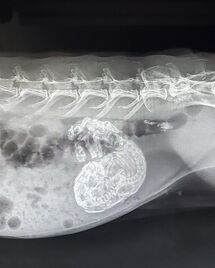
The following are some stories about rare complications in rabbit neuter surgeries:
- Chieh Hsu. (2023). Rabbit required a second spay due to aggression from a small piece of ovary left from original low-cost spay surgery.
- House Rabbit Resource Network. (2022). Clover's story - adhesions developed around her bladder and colon after her spay surgery
- Tiny Paws Rabbit Rescue. (2022). Big bunny Chapman's story - his scrotal sac formed a hematoma; common in bigger rabbits due to excess swelling
- Gainesville Rabbit Rescue. (2022). Aggressive rabbit required a second spay because original surgery only removed uterus and not the ovaries.
- True Hearts for Healing Paws Rescue. (2022). Macadamia's story with adhesions that wrapped around her colon (RIP)
- The Pipsqueakery. (2019). Kaylee's story where uterine cells began growing on organs in her abdominal cavity and binding her intestines together which caused them to stop digesting.
- u/Arehc_89. (2017). Bladder was discovered to be attached to the uterus during spay
- Alison Giese. (2016). Rabbit with escalating hormonal behavior required an additional surgery to remove testicular tissue left over from the original neuter years ago.
- David Sanchez-Migallon Guzman et al. (2014). Colonic Obstruction Following Ovariohysterectomy in Rabbits: 3 Cases
- Kyle Eslinger. (2014). Complications of a Spay
Further reading
The following articles include general information about spaying and neutering rabbits, covering most of the topics above.
- Kinenchen. (2014). Why should I spay or neuter my rabbit?
- Ontario Rabbit Education Organization. Spaying / Neutering
- San Diego House Rabbit Society. Get Your Rabbit Spayed/Neutered
- Rabbit Welfare Association & Fund. Neutering – Castration and Spaying
- Petcoach. Spaying and Neutering Rabbits: Why, When, and How and Post-Operative Care
- Susan Brown, DVM. (2011). Neutering Rabbits is Best
- Astrid Kruse, DVM. Why Spay Your Rabbit?
- William A. Mandel, DVM. (2004). Harelines: Rabbit Spay FAQ’s [PDF]
- Amie Espie. (2000). Spay-Neuter is a Win-Win
- Happy Hoppers Rabbit Forum. Neutering (Spaying & Castration)
- Save a Fluff. Why do I need to have my rabbits neutered?
See also
References
- ↑ Merriam-Webster, neuter
- ↑ 2.00 2.01 2.02 2.03 2.04 2.05 2.06 2.07 2.08 2.09 2.10 2.11 2.12 2.13 House Rabbit Society, FAQ: Spaying and Neutering
- ↑ Dolly's Dream Home Rabbit Rescue. (2024). Post on Facebook. Retrieved 06 Jan 2025 from https://www.facebook.com/groups/432339154749383/posts/1237986777517946/
- ↑ 4.0 4.1 British Small Animal Veterinary Association, Policy Statement on the Neutering of Rabbits
- ↑ kanin.org. (2008). Why you should spay/neuter your rabbit. Retrieved 31 March 2016 from http://kanin.org/node/182
- ↑ 6.0 6.1 6.2 6.3 Dana Krempels, Ph.D., Spay or Neuter my Rabbit?
- ↑ 7.0 7.1 7.2 7.3 7.4 7.5 Varga, M. (2013). Textbook of rabbit medicine. (2nd ed.).
- ↑ Frances Harcourt-Brown, Textbook of Rabbit Medicine, 2002.
- ↑ Give Us a Home, Rabbits
- ↑ McLeod, L. (2014). At What Age Can I Have My Rabbit Spayed or Neutered? Retrieved 14 March 2016 from http://exoticpets.about.com/cs/rabbits/f/rabbitsnage.htm
- ↑ Colorado House Rabbit Society. (2012). A Guide to Having Your Rabbit Safely Neutered. Retrieved 5 April 2016 from https://coloradohrs.org/a-guide-to-having-your-rabbit-safely-neutered/
- ↑ 12.0 12.1 Richardson, V.C.G. (2000). Rabbits: Health, Husbandry and Diseases.
- ↑ MediRabbit. (n.d.). Pre-anesthetic preparations of the rabbit. Retrieved 27 Sep 2018 from http://www.medirabbit.com/EN/Surgery/Anesthesia/Pre/anes_pre_en.htm
- ↑ HRS-Anesthesia Protocols for Rabbits. Retrieved 17 Nov 2018 from https://rabbit.org/anesthesia-protocols-for-rabbits/
- ↑ 15.0 15.1 Krempels, D. (2011). Pre- and Post-operative care of Rabbits. Retrieved 18 Dec 2019 from http://www.bio.miami.edu/hare/opcare.html.
- ↑ 16.0 16.1 Wildpro. (n.d.). Cryptorchidism in Bears and Lagomorphs. Retrieved 28 Jan 2019 from http://wildpro.twycrosszoo.org/S/00dis/Miscellaneous/Cryptorchidism_Bears.htm
- ↑ Lesa Longley, Saunders Solutions in Veterinary Practice: Small Animal Exotic Pet Medicine, 2010.


